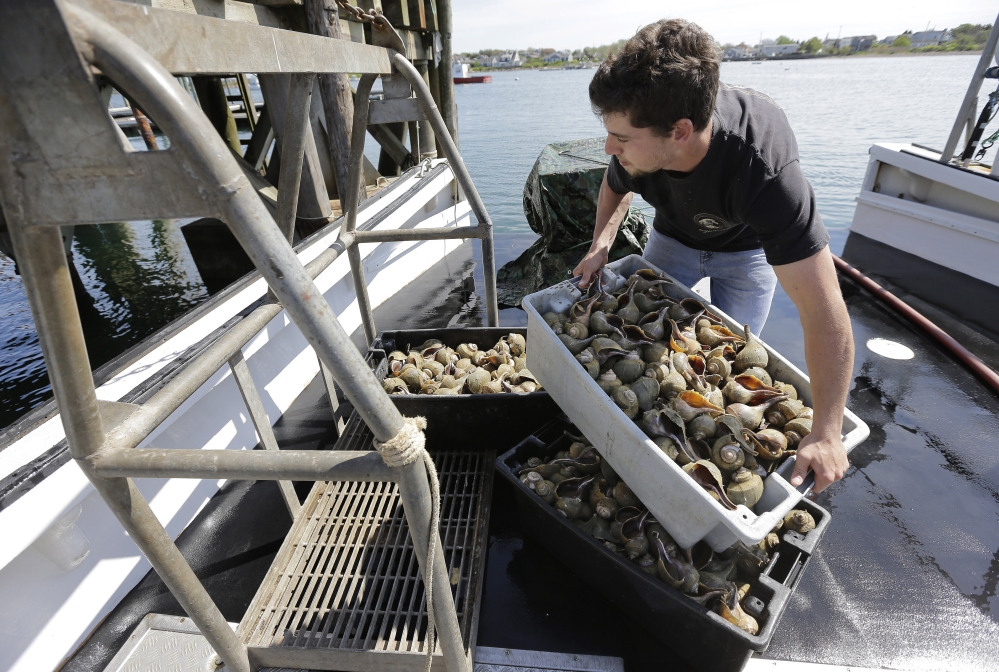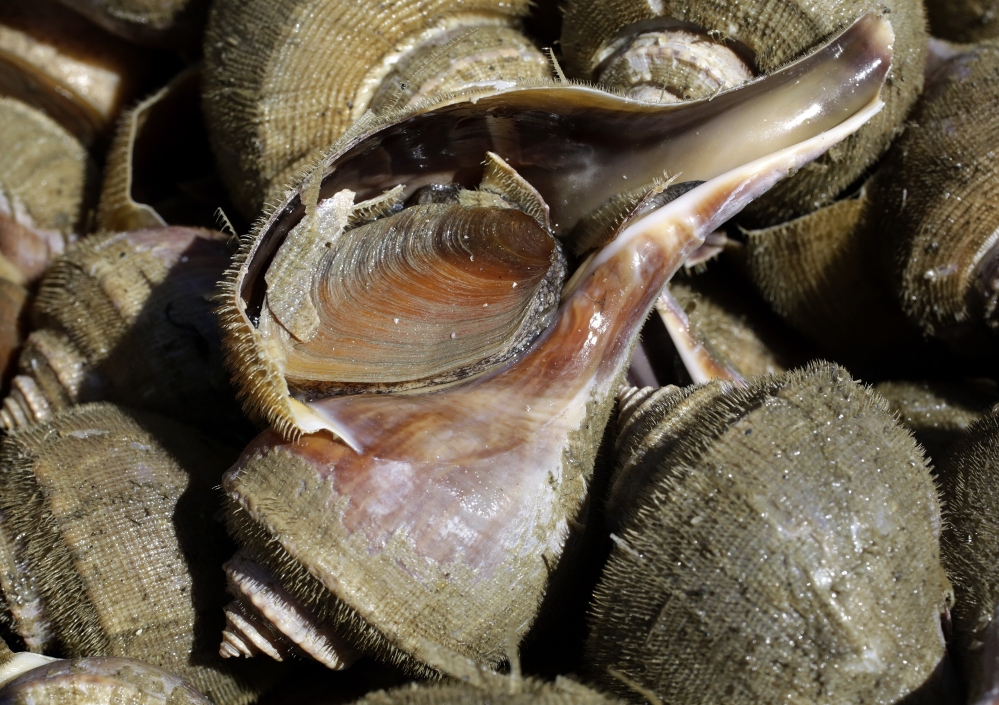LITTLE COMPTON, R.I. — Cooking a channeled whelk is not for the squeamish. But sliced and sprinkled over a bed of linguine, it’s a chewy delicacy in old-fashioned Italian eateries along the East Coast.
The sea snails known by Italian-Americans as scungilli used to be such a niche market that fishermen ignored them when they turned up in lobster traps or oyster dredges.
Now they’re a prized commodity. Because of growing demand in Asia and the collapse of other industries, such as lobster, fishermen searching for something else to catch are keeping and selling the big marine snails.
“There’s an international market for the product, primarily in Hong Kong and South China,” said Rick Robins, who owns Bernie’s Conchs in Virginia and manages export sales for Chesapeake Bay Packing. “It’s a popular item in Cantonese cooking.”
Most people who order a plate of scungilli probably haven’t seen one of the hairy-shelled gastropods in the wild. A voracious predator, it crawls along the bottom of Atlantic coastal inlets from Nantucket Sound to North Carolina’s Outer Banks, piercing its razor-edged proboscis into clams and other prey.
‘THE NORTHERN, UGLY VERSION’
“They’re not like their Caribbean cousin,” said Rhode Island fisherman Greg Mataronas, comparing it to the tropical, vegetarian conch. “They’re the Northern, ugly version. Their faces are a hunk of meat.”
It’s an increasingly lucrative hunk of meat: A large whelk can be sold for as much as $7 in a live market.
The annual dockside value of the whelk catch now tops $1 million in Virginia and Rhode Island, $1.4 million in New Jersey and $5.7 million in Massachusetts, according to marine fishery agencies in those states. In Delaware, knobbed and channeled whelks are now the third most valuable fishery behind blue crabs and striped bass.
In the colder waters of Maine, a smaller waved whelk served up as a “pickled wrinkle” is seeing a resurgence in popularity. The same whelk is also fished in Canada and favored in Korean cuisine, Robins said.
In southern New England, as the lobster industry declined from Cape Cod to Long Island Sound, the market for channeled whelks grew so quickly that states have scrambled to establish rules to let the snails grow big enough to breed.
“As lobster fishing has declined, whelk fishing has increased,” said Scott Morello, a researcher at Maine’s Downeast Institute for Applied Marine Research & Education. “Even so, it’s still not as profitable for a year-round fishery that you’d want to base an entire economy off of it.”
Mataronas identifies himself as a lobsterman, just as his father and grandfather did in the Rhode Island seaside town of Little Compton.
“Lobstering was so good in the ’90s” that he paid no attention to snails, he said. But since 2000, he’s devoted much of his spring and fall to trapping whelks in the calm waters of the Sakonnet River, a tidal strait that flows into Rhode Island Sound. Baited by dogfish meat and horseshoe crabs, the snails crawl into traps left about 10-feet deep on the muddy sea floor.
Some upscale New York City restaurants now feature fresh or even raw whelks on the menu. The old-school Italian restaurants that serve sea snail salad – a popular Christmastime dish – usually get it canned from a handful of specialty processors.
“It’s almost impossible to find fresh scungilli these days,” said Frank Lombardi, owner of Lombardi’s Trattoria in Georgetown, Connecticut.
Lombardi recalls a similar dish from his childhood in Naples, Italy, but culinary experts dispute whether it’s really an Italian food or something invented by Italian-Americans in the Northeast.
“I imagine that early Italian immigrants in the late 19th and early 20th century in Massachusetts, Rhode Island, Connecticut, New York and New Jersey found whelks on the beaches,” said cookbook author Clifford Wright. “It was a cheap food and they were poor people.”
Send questions/comments to the editors.




Comments are no longer available on this story